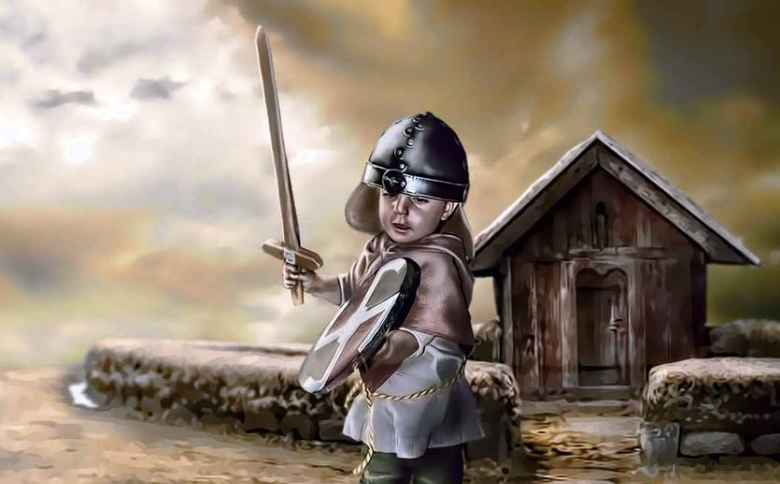We know from the sagas that Viking boys were trained in the art of sword and axe. The Viking's success was no accident: The warrior's mind and body were trained almost from birth until he proudly stepped into Valhalla.
Every little boy knew that they could only become real men through warfare. According to the Eddic poem Rigstula, children learned a variety of skills and combat techniques. The poem tells about the boy Jarl who “tamed horses, made arrows, shaped shields and brandished spears.”
The name Jarl (English: Earl) indicates that the boy comes from a chief’s family, but children from farming families were probably also playing war games.
Historians believe that even three-year-old boys played with wooden swords and threw spears covered by a piece of leather so that they should not hurt themselves or others.
When the children grew older, they could be lucky and get real weapons of iron forged in a child’s size. Norwegian archaeologists have found several such weapons, including a small sword and an axe in a child’s grave.

Viking longswords (not child-sized).
Wrestling and Snowball Fights
Besides playing with weapons, wrestling was one of the most popular games. Through wrestling matches they practiced speed and agility, the training being a good preparation for future close combat situations.
Through wrestling the children also learned game rules and discipline. The Vikings had to promise that they would not hurt each other intentionally during play. These rules were taken very seriously and strictly enforced. Those who broke the rules committed níð (loss of honor) and were often called níðingr (dishonored) – one of the worst epithets in the Viking Age.
When it was snowing, children built ramparts and fortresses that they used as battle arenas. Snowball fighting was not only entertaining but also effective training in siege techniques and different throwing skills.
A Matter of Honor
The most important of all was that the young Viking learned about the warrior society’s code of honor. The Norsemen believed in the inevitability of the wyrd (fate), that the beginning and the end of the life were predetermined and that no one could die before its time.
It was this very belief is what forged the Vikings into fearless warriors. If the time of death is already determined, all that is left is the manner in which to die: with valor, earning a place in Valhalla; or in shame, falling into Hel's clutches.

Norns weaving the Wyrd.
In every battle, one of two things will happen: either you will fall, or you will survive. Therefore, be brave because everything is predetermined. Nothing can kill a man if his time has not come, and no one can save the one who is destined to die. So a farmer exhorts his son in Sverris saga while they are walking together down to the longship waiting at the coast.
In the same way, to die in battle was the most honorable a thing a Viking could achieve. The ability to plunder was also highly respected – unlike ordinary thefts which were considered cowardly actions.
Early Debut
Viking boys had to prove that they had the courage and skills before they were considered as grownups. If they belonged to a powerful family, they could prove themselves worthy by participating in a battle or go on Viking.

Young Vikings practiced wrestling and close combat.
The sagas mention that Olaf Tryggvason (c. 963-1000 AD) killed his first man when he was nine years old.
Olaf Haraldsson (995 – 29 July 1030 AD), who later became Olaf the Holy, went on Viking when he was twelve years old.
Although the saga writers are exaggerating in their eagerness to glorify the heroes, they provide an image of how the children already at an early stage had to live up to the expectations the Viking society demanded.
The sagas say nothing about whether young girls were trained in the art of war. This may be because they were written down after Christianity was introduced in Scandinavia and that warrior women were not tolerated in Christianity.
We still don't have archeological evidence of young girls also training with weapons, but due to the nature of the Shieldmaiden role and the more equalitarian gender society that the Vikings had, this is almost a certainty.













